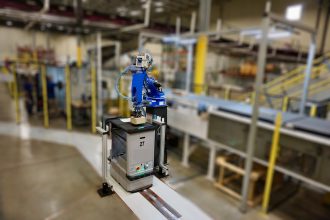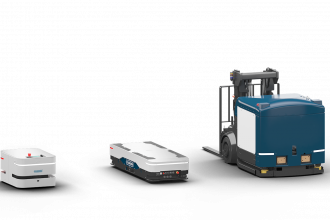What is a Mesh Network?

A mesh network is one way to provide online connectivity to devices, just like Wi-Fi or LTE. Mesh networks are unique because instead of each device connecting to a single centralized access point, mesh networks feature nodes, or signal bridging devices, arranged in a mesh or web-like structure that serve as connectivity points.
Mesh Networks Are More Reliable
Traditional high-risk networks must establish a clear line of sight to afford coverage. Harsh weather, tall buildings, and even interference from nearby devices may challenge the integrity of other networks, while Kinetic Mesh networks will function properly despite those obstacles. The nodes that comprise mesh networks make signal transmission possible through multi-node connectivity. Even if a clear line of sight isn’t available for one or two nodes, the signal will route around the obstacle through a series of other nearby nodes until it reaches its intended destination.
Mesh Networks Offer More Bandwidth
In traditional high-risk networks, there is only so much bandwidth to go around. That bandwidth is divided among all the clients paying for usage, and the bandwidth is often restricted and unreliable, especially during peak busy times.
In contrast, mesh networks are closed-private networks built with high bandwidth and can produce a data rate of up to 450 Mbps. Further, nodes in mesh networks make it possible to have multiple devices sending packets over multiple paths simultaneously, as well as various drop-off points that allow consumers to quickly get information from the client device to the network infrastructure. In turn, mesh networks offer more bandwidth with fewer congestion issues.
Mesh Networks Are Easier to Scale
There are a few factors that come into play when it comes to scaling traditional high-risk networks. Base station and tower placement, frequency availability, and the number of access points within the network must all be considered. If scaling is necessary, base stations, towers, and access points must be added at fixed locations—and those get expensive, fast.
Mesh networks are much easier to scale. For example, mesh wireless networks use frequencies that offer larger amounts of bandwidth and are more readily available around the globe to support various business applications. To expand the mesh network, users simply add additional nodes wherever or on whatever they’re needed.
Industrial Space & Autonomous Robotics
Mesh networks are for all businesses. Gone are the days of static operations and fixed networking infrastructure. Mesh network technology has already demonstrated, beyond public broadband or centralized Wi-Fi alternatives, to be incredibly effective at ensuring operational security.
This includes enabling automated guided vehicles and autonomous robots; automated inventory identification, data capture and sortation, and remote operation of storage, retrieval, and material handling systems to keep workers off the floor themselves. The continuous mobile connectivity provided by the wireless Mesh networks can also be used for telemetry to monitor equipment health dynamically and for real-time video to monitor worker safety.
Today, remotely guided and autonomous indoor industrial machinery demands ‘never-break’ wireless communications, but metal shelving and equipment can block radio frequency (RF) signals and cause automated systems to grind to a halt. Mesh networks can be easily placed where needed to work around obstructions. These compact, lightweight nodes can even be deployed on mobile robots, equipment, and personnel working between the racks to readily extend coverage to the hardest-to-reach areas.
Every business’ needs are different, but if reliability and scalability are top-of-mind, mesh networks are the safest bet. With hardware and software to uniquely protect against interference, long distances, and harsh environments, mesh networks are built for reliable, scalable, and adaptable communications that can easily be tailored to meet your business’ needs. With a more reliable infrastructure that makes mission-critical communications always possible, mesh networks will undoubtedly spearhead the long overdue digital transformation many businesses have been waiting for, bridging technologies—from nodes to signals—to ensure safer, more effective business operations.
 Mobile Automation Group (MAG) members are the Industry’s leading suppliers of automatic guided vehicle systems. They supply systems worldwide and in virtually every major manufacturing and distribution sector.
Mobile Automation Group (MAG) members are the Industry’s leading suppliers of automatic guided vehicle systems. They supply systems worldwide and in virtually every major manufacturing and distribution sector.
Both Automatic Guided Vehicles (AGVs) and Autonomous Mobile Robots (AMRs) are computer-controlled wheel-based load carriers (normally battery powered) that run on a plant or warehouse floor (or, if outdoors, on a paved surface). The main difference between AGVs and AMRs is how the path they follow is determined.
- Most AGVs follow predefined paths, although there may be areas of the plant or warehouse where they have more freedom.
- AMRs can determine their own path, although they will attempt to follow suggested paths if they exist.
This difference leads to differing methodologies for ensuring safe operation for the two types of vehicle.
- AGVs follow the ANSI B56.5 Safety Guidelines
- AMRs follow the R15.08 Standard
To find out more about MHI’s MAG Industry Group: mhi.org/mag
For further articles/podcasts from MAG:
Podcast: Sensors Revolutionizing Automated Material Movement: Efficiency And Safety Enhanced
Powering Tomorrow’s Mobile Automation
The Unexpected (Soft) Benefits Of Mobile Automation
Navigating The Mobile Automation Landscape
Getting Started With Mobile Automation
The Unexpected (Soft) Benefits Of Mobile Automation



